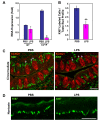Lipopolysaccharide-induced inflammation attenuates taste progenitor cell proliferation and shortens the life span of taste bud cells
- PMID: 20537148
- PMCID: PMC2898829
- DOI: 10.1186/1471-2202-11-72
Lipopolysaccharide-induced inflammation attenuates taste progenitor cell proliferation and shortens the life span of taste bud cells
Abstract
Background: The mammalian taste bud, a complex collection of taste sensory cells, supporting cells, and immature basal cells, is the structural unit for detecting taste stimuli in the oral cavity. Even though the cells of the taste bud undergo constant turnover, the structural homeostasis of the bud is maintained by balancing cell proliferation and cell death. Compared with nongustatory lingual epithelial cells, taste cells express higher levels of several inflammatory receptors and signalling proteins. Whether inflammation, an underlying condition in some diseases associated with taste disorders, interferes with taste cell renewal and turnover is unknown. Here we report the effects of lipopolysaccharide (LPS)-induced inflammation on taste progenitor cell proliferation and taste bud cell turnover in mouse taste tissues.
Results: Intraperitoneal injection of LPS rapidly induced expression of several inflammatory cytokines, including tumor necrosis factor (TNF)-alpha, interferon (IFN)-gamma, and interleukin (IL)-6, in mouse circumvallate and foliate papillae. TNF-alpha and IFN-gamma immunoreactivities were preferentially localized to subsets of cells in taste buds. LPS-induced inflammation significantly reduced the number of 5-bromo-2'-deoxyuridine (BrdU)-labeled newborn taste bud cells 1-3 days after LPS injection, suggesting an inhibition of taste bud cell renewal. BrdU pulse-chase experiments showed that BrdU-labeled taste cells had a shorter average life span in LPS-treated mice than in controls. To investigate whether LPS inhibits taste cell renewal by suppressing taste progenitor cell proliferation, we studied the expression of Ki67, a cell proliferation marker. Quantitative real-time RT-PCR revealed that LPS markedly reduced Ki67 mRNA levels in circumvallate and foliate epithelia. Immunofluorescent staining using anti-Ki67 antibodies showed that LPS decreased the number of Ki67-positive cells in the basal regions surrounding circumvallate taste buds, the niche for taste progenitor cells. PCR array experiments showed that the expression of cyclin B2 and E2F1, two key cell cycle regulators, was markedly downregulated by LPS in the circumvallate and foliate epithelia.
Conclusions: Our results show that LPS-induced inflammation inhibits taste progenitor cell proliferation and interferes with taste cell renewal. LPS accelerates cell turnover and modestly shortens the average life span of taste cells. These effects of inflammation may contribute to the development of taste disorders associated with infections.
Figures







Similar articles
-
Differential expression of a BMP4 reporter allele in anterior fungiform versus posterior circumvallate taste buds of mice.BMC Neurosci. 2010 Oct 13;11:129. doi: 10.1186/1471-2202-11-129. BMC Neurosci. 2010. PMID: 20942907 Free PMC article.
-
Inflammation activates the interferon signaling pathways in taste bud cells.J Neurosci. 2007 Oct 3;27(40):10703-13. doi: 10.1523/JNEUROSCI.3102-07.2007. J Neurosci. 2007. PMID: 17913904 Free PMC article.
-
Quantitative Analysis of Taste Bud Cell Numbers in the Circumvallate and Foliate Taste Buds of Mice.Chem Senses. 2020 May 21;45(4):261-273. doi: 10.1093/chemse/bjaa017. Chem Senses. 2020. PMID: 32157267
-
Abundant proliferating cells within early chicken taste buds indicate a potentially "built-in" progenitor system for taste bud growth during maturation in hatchlings.Histol Histopathol. 2019 May;34(5):503-511. doi: 10.14670/HH-18-055. Epub 2018 Oct 31. Histol Histopathol. 2019. PMID: 30378645 Free PMC article.
-
Taste bud homeostasis in health, disease, and aging.Chem Senses. 2014 Jan;39(1):3-16. doi: 10.1093/chemse/bjt059. Epub 2013 Nov 28. Chem Senses. 2014. PMID: 24287552 Free PMC article. Review.
Cited by
-
To Detect and Reject, Parallel Roles for Taste and Immunity.Curr Nutr Rep. 2021 Jun;10(2):137-145. doi: 10.1007/s13668-021-00355-3. Epub 2021 Apr 22. Curr Nutr Rep. 2021. PMID: 33886074 Free PMC article. Review.
-
Inflammation arising from obesity reduces taste bud abundance and inhibits renewal.PLoS Biol. 2018 Mar 20;16(3):e2001959. doi: 10.1371/journal.pbio.2001959. eCollection 2018 Mar. PLoS Biol. 2018. PMID: 29558472 Free PMC article.
-
Ingestion of bacterial lipopolysaccharide inhibits peripheral taste responses to sucrose in mice.Neuroscience. 2014 Jan 31;258:47-61. doi: 10.1016/j.neuroscience.2013.10.072. Epub 2013 Nov 9. Neuroscience. 2014. PMID: 24215981 Free PMC article.
-
Lipopolysaccharide-Induced Inflammatory Cytokine Expression in Taste Organoids.Chem Senses. 2020 Apr 17;45(3):187-194. doi: 10.1093/chemse/bjaa002. Chem Senses. 2020. PMID: 31993633 Free PMC article.
-
Obesity alters the gustatory perception of lipids in the mouse: plausible involvement of lingual CD36.J Lipid Res. 2013 Sep;54(9):2485-94. doi: 10.1194/jlr.M039446. Epub 2013 Jul 9. J Lipid Res. 2013. PMID: 23840049 Free PMC article.
References
-
- De Conno F, Ripamonti C, Sbanotto A, Ventafridda V. Oral complications in patients with advanced cancer. J Palliat Care. 1989;5:7–15. - PubMed
-
- Deems DA, Doty RL, Settle RG, Moore-Gillon V, Shaman P, Mester AF, Kimmelman CP, Brightman VJ, Snow JB. Smell and taste disorders, a study of 750 patients from the University of Pennsylvania Smell and Taste Center. Arch Otolaryngol Head Neck Surg. 1991;117:519–528. - PubMed
-
- Schiffman SS, Graham BG. Taste and smell perception affect appetite and immunity in the elderly. Eur J Clin Nutr. 2000;54:S54–S63. - PubMed
Publication types
MeSH terms
Substances
Grants and funding
LinkOut - more resources
Full Text Sources

